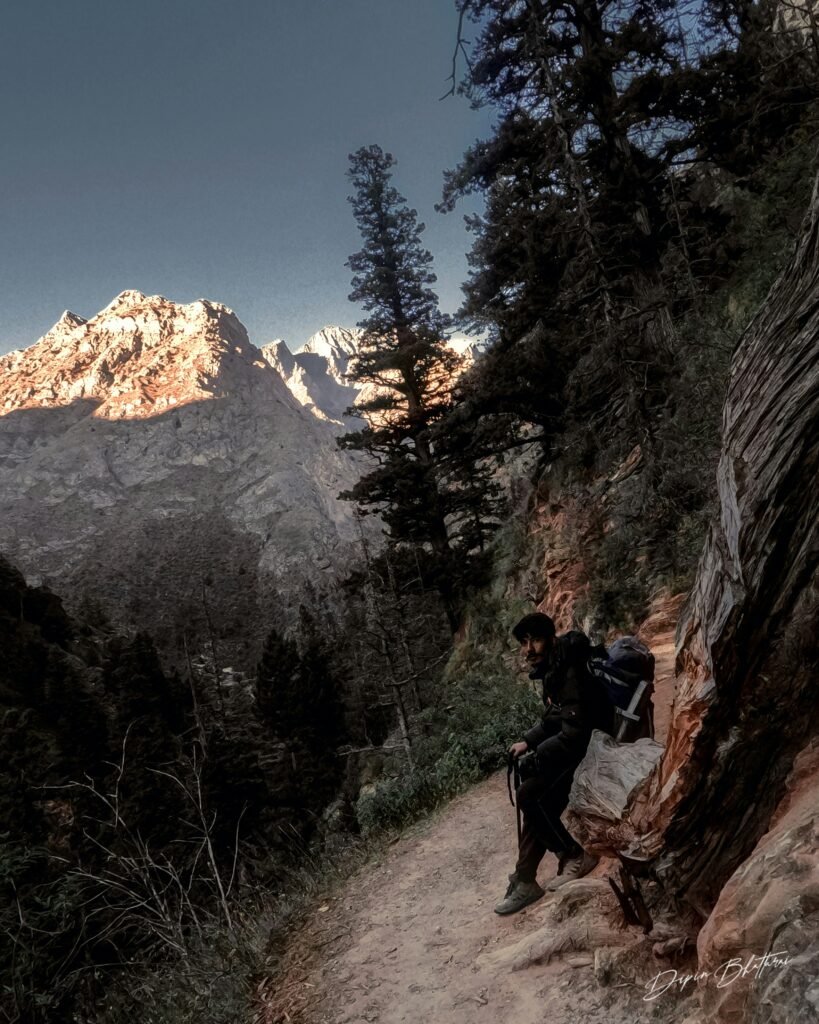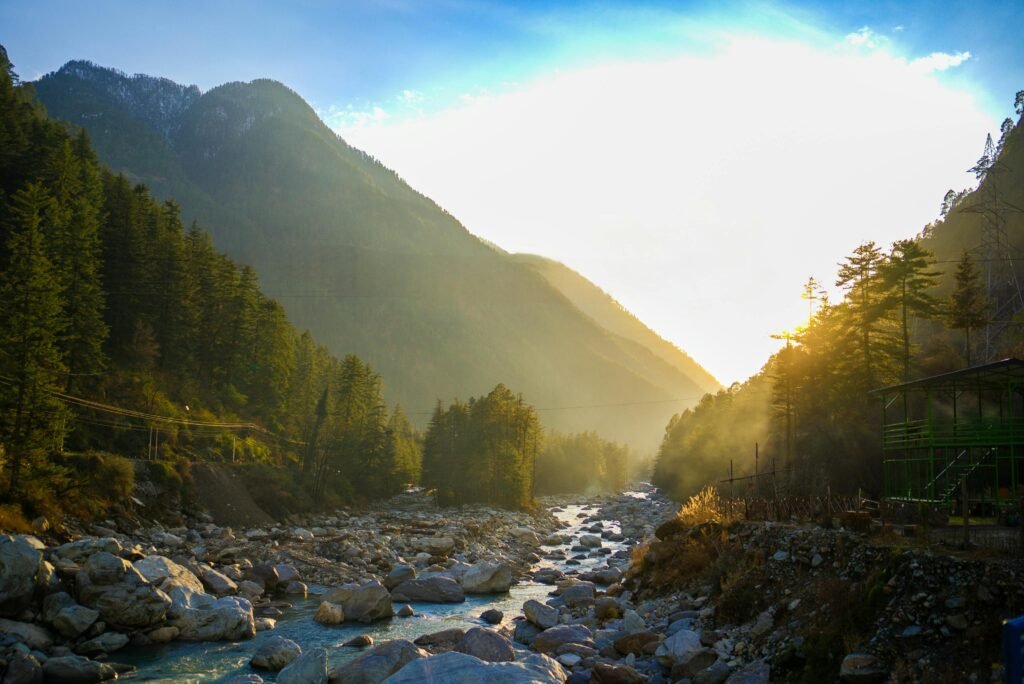Last updated: October 2025
Ever dreamed of walking from one state to another with everything you need on your back? Well you should. That’s what thru-hiking is all about.
Picture this: you wake up in your tent to the sound of birds chirping, zip open your door to a sunrise over mountain peaks, and remember that you don’t have traffic to beat or tasks to get done, you’ve got another 20 miles of trail ahead of you today. And tomorrow. And for the next four months. Sound crazy? Welcome to thru-hiking—one of the most challenging through rewarding, and life-changing adventures you can embark on.
If you’ve ever wondered what drives people to spend months walking thousands of miles through wilderness, carrying their entire world on their backs, you’re in the right place. This guide will walk you through everything you need to know about what thru-hiking is, how it differs from other types of hiking, and whether this incredible adventure might be calling your name.
Table of Contents
*This post may contain affiliate links. If you use them, I may earn a small commission at no extra cost to you.
What Exactly Is Thru-Hiking?
Let’s start with the basics. Thru-hiking means completing an entire long-distance trail from end to end in one continuous journey, typically within a single hiking season. We’re not talking about a weekend backpacking trip here—we’re talking about epic adventures that can take anywhere from a few weeks to six months or more. Yes, half a year hiking. I know sounds amazing!
How Thru-Hiking Differs From Other Types of Hiking
If you’re new to the hiking world, you might be wondering how thru-hiking fits into the bigger picture of outdoor adventures. Here’s how it compares to other forms of walking and hiking:
Day Hiking: Single-day adventures where you return to your starting point or a nearby trailhead. You carry minimal gear—just water, snacks, and safety essentials. Perfect for exploring local trails or specific destinations within a few hours’ walk. More on day hiking: Day Hiking 101: Planning, Gear, and Trail Etiquette for success
Backpacking: Multi-day hiking trips where you carry camping gear and food for 2-7 days typically. You might explore a wilderness area, complete a loop trail, or hike point-to-point over a long weekend. This is like thru-hiking’s shorter cousin.
Section Hiking: Completing long trails in segments over multiple trips and years. It’s the same end goal as thru-hiking but broken into manageable chunks that fit around your regular life.
Fastpacking: A hybrid of running and backpacking where you cover long distances quickly with minimal gear. Think ultralight backpacking at a running pace rather than walking pace.
Trekking: Often used to describe hiking in international destinations, particularly multi-day adventures with guide services, porters, or established hut systems (like Nepal’s Everest Base Camp trek).
Walking/Rambling: Leisurely walks on established paths, often in settled areas. Popular in places like England’s countryside, where “rambling” refers to pleasant walks through pastoral landscapes.
What makes thru-hiking unique? It’s the combination of extreme distance, continuous travel, self-sufficiency, and extended time commitment that sets it apart. While a backpacker might spend a week in the wilderness, thru-hikers spend months. While day hikers return home each evening, thru-hikers live on the trail for the entire journey.
The big three trails that most people think of when they hear “thru-hike” are:
The Appalachian Trail (AT): 2,190 miles from Georgia to Maine The Pacific Crest Trail (PCT): 2,650 miles from Mexico to Canada The Continental Divide Trail (CDT): 3,100 miles along the Rocky Mountains
But thru-hiking isn’t limited to these famous routes. You can thru-hike trails of various lengths, from a few hundred miles to several thousand. What matters is the commitment to hiking the entire trail continuously, without skipping sections.
The Philosophy Behind Thru-Hiking
Here’s what makes thru-hiking special: it’s not just about the physical challenge of covering massive distances. It’s about the mental journey, the gradual transformation that happens when you strip life down to its essentials and spend months moving through the natural world at walking pace. Think of it as an alternative to sitting on the top of a mountain and meditating (or do it as part of your thru-hike)
Many long-distance hikers describe it as a moving meditation, a chance to disconnect from the complexity of modern life and reconnect with something more fundamental. You’ll hear terms like “trail magic,” “hiker midnight” (9 PM), and “vitamin I” (ibuprofen) that become part of a shared language among the hiking community.
Thru-Hiking vs. Section Hiking: What’s the Difference?
This is one of the most common questions beginners ask, and understanding the difference is crucial for planning your adventure.
Thru-Hiking: The All-In Approach
Thru-hiking means completing the entire trail in one continuous journey. You start at one end, walk every single mile, and finish at the other end without taking extended breaks or skipping sections. Most thru-hikers complete their journeys within 4-6 months, depending on the trail length and their hiking pace.
Benefits of thru-hiking:
- Complete immersion in trail life and culture
- Stronger sense of accomplishment
- Better chance of experiencing the full seasonal changes along the trail
- Deeper connections with fellow thru-hikers
- Simplified logistics once you’re on trail
Challenges of thru-hiking:
- Requires extended time away from work and responsibilities
- Higher physical and mental demands
- More intensive planning and preparation
- Greater financial commitment upfront
Section Hiking: The Flexible Alternative
Section hiking means completing a long-distance trail in segments over multiple trips, often spanning several years. You might hike 200 miles of the Appalachian Trail one summer, then return to hike another section the following year.
Benefits of section hiking:
- Fits better with work and family commitments
- Allows you to experience different seasons on the same trail
- More flexibility in planning and budgeting
- Can adjust gear and strategy between sections
- Less intimidating for beginners
Challenges of section hiking:
- Requires more complex logistics over time
- May miss out on some of the community aspects
- Harder to maintain trail fitness between sections
- Can take many years to complete a full trail
| Aspect | Thru-Hiking | Section Hiking |
|---|---|---|
| Time Commitment | 4-6 months continuous | Weeks per section over multiple years |
| Planning Complexity | High upfront, simpler on trail | Moderate but ongoing |
| Physical Demands | Intense sustained effort | Manageable segments |
| Community Experience | Deep immersion | Intermittent connection |
| Flexibility | Limited once started | High between sections |
| Cost Pattern | Large upfront investment | Spread over multiple years |
Why Do People Choose Long-Distance Hiking?
The reasons people are drawn to thru-hiking are as diverse as the hikers themselves, but certain themes come up again and again:
The Ultimate Challenge
There’s something deeply satisfying about setting an ambitious goal and following through. Thru-hiking pushes you to your physical and mental limits, then shows you that those limits were further than you thought. Many hikers describe it as the hardest thing they’ve ever done—and the most rewarding experience of self-discovery.
Simplicity and Minimalism
In our complex, technology-saturated world, the simplicity of thru-hiking can be incredibly appealing. Your daily concerns boil down to basics: where will you sleep tonight, do you have enough food and water, and how many miles can you cover today? Many hikers find this simplicity liberating.
Nature Immersion Like No Other
While day hikers and backpackers get tastes of wilderness, thru-hikers get the full meal. You experience the gradual changes in ecosystems, weather patterns, and seasons in a way that’s impossible in shorter trips. You become intimately familiar with the rhythms of the natural world.
The Trail Community
The thru-hiking community is legendary for its supportiveness and camaraderie. Trail names, hiker feeds, trail angels, and the general culture of helping fellow hikers creates bonds that often last a lifetime. Many hikers say the people they meet are the highlight of their journey.
Personal Transformation
This might sound dramatic, but many thru-hikers describe their journey as life-changing. Months of physical challenge, simplified living, and time for reflection can shift perspectives on what’s truly important. Don’t be surprised if you come off the trail with a different outlook on career, relationships, and life priorities.

Planning Your First Thru-Hike: The Essential Steps
Ready to start planning? Here’s your roadmap to making it happen:
Step 1: Choose Your Trail Wisely
Not all long-distance trails are created equal. Consider these factors:
- Trail Length: Starting with a shorter trail (500-1,000 miles) can build confidence for longer adventures
- Terrain Difficulty: Rocky trails like parts of the AT are tougher on feet and knees than smoother trails
- Weather Patterns: Some trails have narrow weather windows, while others are more forgiving
- Permit Requirements: Popular trails may require advance permits or have lottery systems
- Resupply Infrastructure: Well-established trails have better town access and services
Popular starter trails include:
- Long Trail (Vermont): 273 miles
- John Muir Trail (California): 211 miles
- Colorado Trail: 486 miles
- Superior Hiking Trail (Minnesota): 310 miles
Step 2: Build Your Fitness Foundation
Thru-hiking fitness goes beyond just being able to walk long distances. You need to build:
- Cardiovascular Endurance: Ability to maintain moderate effort for 8-12 hours daily
- Leg and Core Strength: Power for uphills and stability for downhills
- Pack-Carrying Stamina: Hiking with 20-30 pounds feels very different from day hiking
- Recovery Capacity: Your body needs to bounce back quickly for tomorrow’s miles
Training timeline: Start serious training 4-6 months before your hike. Begin with shorter distances and lighter packs, gradually increasing both over time.
Extra resources on preparation:
- How to Train for Hiking? a Long-Distance and Elevation-Heavy Hike Complete 2025 Guide
- How to Build Endurance for Multi-Day Trekking?
Step 3: Master the Gear Game
Thru-hiking gear is all about the balance between having what you need and keeping weight manageable. Every ounce matters when you’re carrying it for thousands of miles.
The Big Four (your heaviest items):
- Backpack: 40-65 liters, prioritize fit and comfort over features
- Shelter: Ultralight tent, tarp, or hammock setup (1-3 pounds)
- Sleep System: Sleeping bag/quilt plus sleeping pad (2-4 pounds combined)
- Base Layers and Rain Gear: Quality clothing that layers well
Recommendations:
Research different options and see what fits best for you, but as a starting point, here are a few recommended options for each gear type:
| Gear Type | Suggested Product | Why It Works for Thru-Hiking |
|---|---|---|
| Backpack | Naturehike Mountain Bag | Durable, ergonomic, good-sized |
| Shelter | Cloud Up Pro 1 Tent | Under 3 lb, compact & solo-friendly |
| Sleep System | Naturehike Ultralight | Ultra-light, flexible, minimalist |
| Alternative Quilt Options | Zoobelives, Feathered Friends, Enlightened Equipment | Proven ultralight warmth and comfort |
| Alternative Tents | Big Agnes UL, Nemo Hornet Elite, Durston X-Mid | Varying setups for solo or duo hikers |
| Alternative Backpack | Sierra Designs Flex Capacitor | Expandable, comfortable, trail-tested |
Pro tip: Total base weight (everything except food, water, and fuel) should ideally be under 20 pounds for long-distance comfort.
Step 4: Plan Your Resupply Strategy
Resupply planning is where many first-time thru-hikers get overwhelmed. You have several options:
- Mail Drops: Ship boxes to yourself at post offices or businesses along the trail
- Buy as You Go: Purchase food in trail towns (more expensive but flexible)
- Hybrid Approach: Mail drops for remote sections, buy in towns when possible
Budget planning: Expect to spend $2,000-5,000 for a long thru-hike, including gear, food, lodging, and transportation.
The Mental Game: Preparing Your Mind for Long-Distance Hiking
Physical preparation gets most of the attention, but the mental aspect of thru-hiking is equally important. Here’s what to expect:
The Stages of a Thru-Hike
Most thru-hikers experience predictable mental phases:
- Honeymoon Phase (First 2-4 weeks): Everything is new and exciting
- The Grind (Weeks 4-8): Reality sets in, enthusiasm may wane
- Finding Your Rhythm (Month 2-3): You adapt to trail life
- The Home Stretch (Final weeks): Mix of excitement and reluctance to finish
Mental Strategies That Work
Embrace the Suck: Bad days happen. Weather, injuries, equipment failures, and low morale are all part of the experience. Accept them rather than fighting them.
Focus on Process, Not Outcome (Hike before destination): Instead of thinking “I have 1,500 miles left,” focus on today’s goals: reach the next water source, make it to that shelter, or simply take the next step.
Build Your Support Network: Stay connected with family and friends, engage with fellow hikers, and don’t hesitate to reach out when you’re struggling.
Celebrate Small Victories: Reaching state lines, hitting mileage milestones, or conquering challenging sections—acknowledge your progress along the way.
Section Hiking vs. Thru-Hiking: Which Path Should You Choose?
Still torn between section hiking vs thru-hiking? Here’s how to decide:
Choose Section Hiking If:
- You can’t take 4-6 months away from work or family
- You’re new to backpacking and want to build experience gradually
- You prefer having more control over timing and conditions
- You want to spread the financial cost over multiple years
- You enjoy the planning and anticipation aspects of multiple trips
Choose Thru-Hiking If:
- You can arrange extended time away from responsibilities
- You’re drawn to the challenge and adventure of continuous travel
- You want the full immersion experience of trail culture
- You prefer to tackle big goals all at once
- You’re ready for a potentially life-changing adventure
There’s no wrong choice. Both approaches offer incredible experiences and personal growth opportunities. Many people start with section hiking and eventually work up to thru-hiking, while others jump straight into the deep end with a full thru-hike.
Popular Long-Distance Trails for Beginners

If you’re considering your first long-distance hiking adventure, here are some excellent options:
Shorter Trails (Under 500 Miles)
- John Muir Trail (California): 211 miles of spectacular Sierra Nevada scenery
- Long Trail (Vermont): 273 miles through Vermont’s Green Mountains
- Wonderland Trail (Washington): 93 miles around Mount Rainier
- Tahoe Rim Trail (California/Nevada): 165 miles around Lake Tahoe
Intermediate Trails (500-1,500 Miles)
- Colorado Trail: 486 miles through Colorado’s Rocky Mountains
- Arizona Trail: 800 miles from Mexico to Utah
- Ice Age Trail (Wisconsin): 1,200 miles when complete
- Florida Trail: 1,100 miles through diverse Florida ecosystems
The Big Three (2,000+ Miles)
- Appalachian Trail: The most social and supported of the big trails
- Pacific Crest Trail: Diverse terrain from desert to alpine
- Continental Divide Trail: The wildest and most challenging
Essential Resources for Aspiring Thru-Hikers
Online Communities
- r/thruhiking (Reddit): Active community with advice and trip reports
- WhiteBlaze.net: Appalachian Trail focused forum
- PCT-L Mailing List: Pacific Crest Trail community
- Guthook Guides: GPS navigation apps for major trails
Essential Reading
- “AWOL on the Appalachian Trail” by David Miller: Classic AT thru-hiking memoir
- “Wild” by Cheryl Strayed: PCT section hike that inspired many
- “Yogi’s PCT Handbook“: Comprehensive PCT planning guide
- Trail-specific guidebooks and data books
Gear Resources
Gear review websites: OutdoorGearLab, REI Expert Advice
Ultralight communities: r/Ultralight, Backpacking Light
Gear shakedown services: Many experienced hikers offer pack reviews
Your Journey Starts With a Single Step
So, what is thru-hiking? It’s an adventure that combines physical challenge, mental growth, natural beauty, and human connection in ways that few other experiences can match. Whether you choose to tackle a full thru-hike or start with section hiking, you’re embarking on a journey that has the potential to change your life.
The trail doesn’t care about your age, background, or previous hiking experience—it only cares about your determination to keep moving forward. Every thru-hiker started as a beginner, wondering if they could really walk that far with everything on their back.
Ready to take the first step? Start by researching trails that appeal to you, begin building your fitness, and connect with the hiking community. The trail is waiting, and your adventure can begin whenever you’re ready to lace up your boots and start walking.
Remember: you don’t have to be extraordinary to do extraordinary things. You just have to be willing to take it one step at a time, one mile at a time, one day at a time. The trail will teach you everything else you need to know.
Your thru-hiking adventure starts with a single step. Are you ready to take it?

Leave a Reply